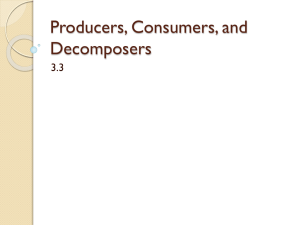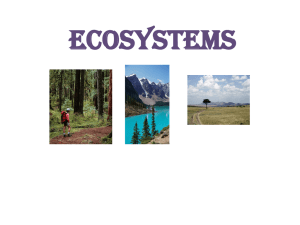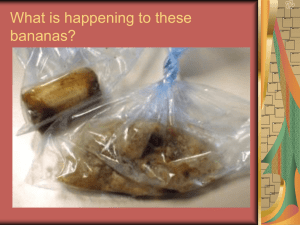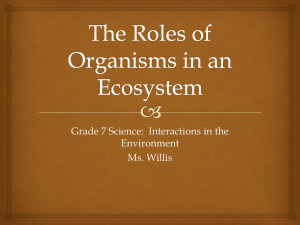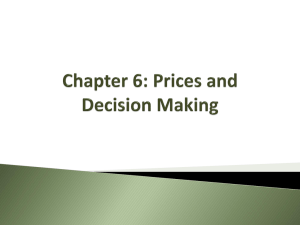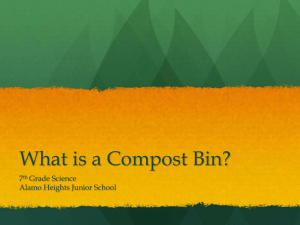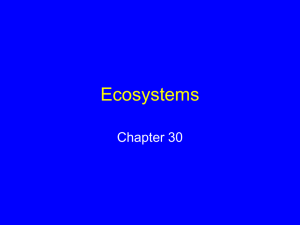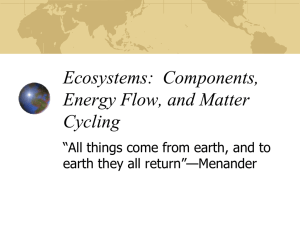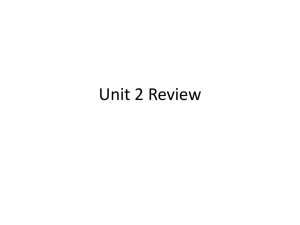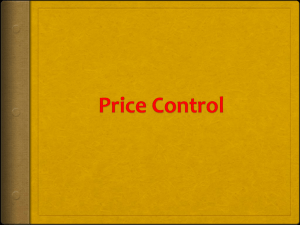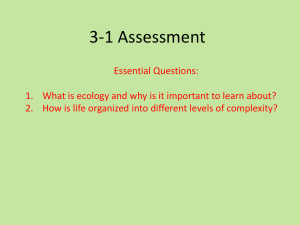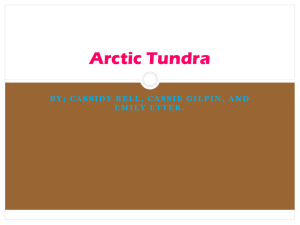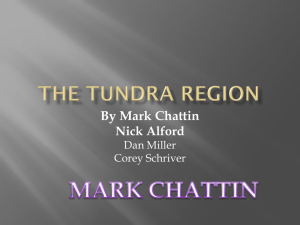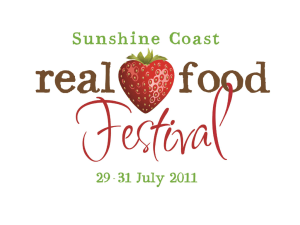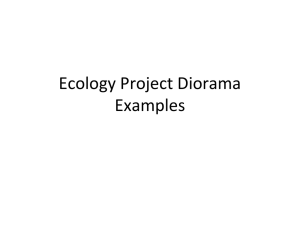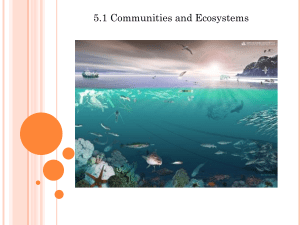Organisms and Where They Live
advertisement
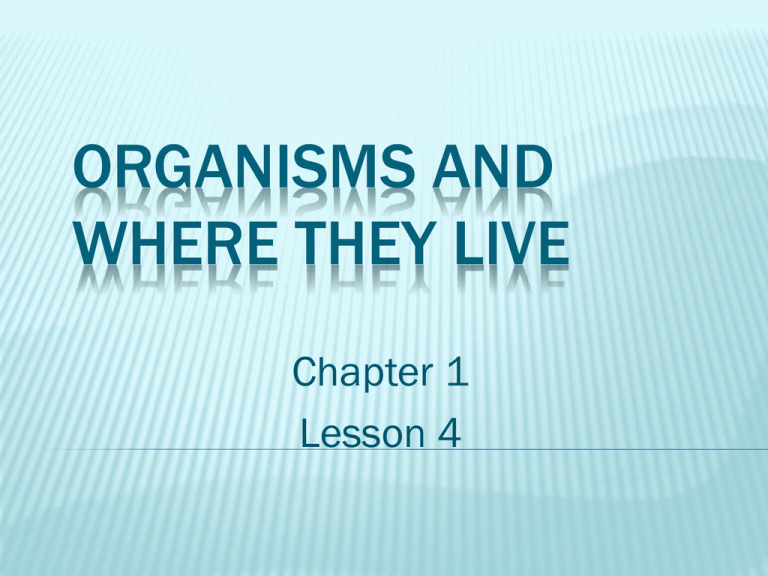
ORGANISMS AND WHERE THEY LIVE Chapter 1 Lesson 4 OBJECTIVES Students will: Explore how all the living and nonliving parts of an environment interact. Describe how the living organisms interact with each other and with non-living parts of an environment. DEFINITIONS Ecology: The study of how living and non-living things interact. DEFINITIONS Ecosystem: The living and non-living things in an environment and all their interactions. COMMUNITY Each ecosystem has its own community. The community is the living parts of the ecosystem. A terrarium’s community can have small plants and animals. A desert community includes beautiful cacti and deadly scorpions. COMMUNITY POPULATION Communities can be divided into different populations. A population is made of only one type of organism. HABITAT Each organism’s home is called a habitat. A whale’s habitat is the ocean. A termite’s habitat is a termite nest. HOW ARE ECOSYSTEMS DIFFERENT? What makes one ecosystem different from another? In many cases water is the key. Only a small number of species of plants and animals can survive with little water. HOW ARE ECOSYSTEMS DIFFERENT? Another important resource that can affect an ecosystem is soil. Areas with soil rich in nutrients can support many plants. Few plants grow in areas with soil that does not have many nutrients. HOW ARE ECOSYSTEMS DIFFERENT? The types of plants and animals that live in a particular ecosystem depend on a combination of these things. A woodland forest has enough rich soil and enough water for many grasses to grow. However, a woodland forest does not have enough sunshine which is needed by most types of grasses. Why? The sun’s light is blocked by the trees and the forest floor is dark. WHAT KINDS OF ECOSYSTEMS ARE THERE? Climate differences produce a variety of ecosystems. Climate is the long-term weather pattern of an area. TUNDRA Long, dark, and very cold winters. Few trees. Ground is frozen for most of the year, and trees can’t grow. Not easy to survive in these very cold places. Most tundra regions are in the Arctic. There is a small amount of tundra on parts of the Antarctic that are not covered with ice. Tundra is also found on mountains at high altitudes and it’s called alpine tundra. TUNDRA In the summer, energy from the Sun thaws the top surface of the ground. Plants grow, but trees can't because the ground is frozen a few inches down. Lots of animals go to the tundra in the summer. Some even stay through the cold winter! ARCTIC FOX CARIBOU GRIZZLY BEAR HARLEQUIN DUCK MUSK OX POLAR BEAR SNOWY OWL MAP OF THE TUNDRA REGIONS TAIGA It is located south of the tundra region. Very cold winters & cool summers. More rain or snow falls than in the tundra. Many fir and spruce trees grow in this region. Yellowstone, Sequoia, and Yosemite are national parks in the Taiga regions of the United States. GRASSLANDS Cold winters & hot summers. More rain or snow falls than in the taiga. Rich soil. Grassland biomes are large, rolling terrains of grasses, flowers and herbs. We may know this areas as the “prairie.” GRASSLANDS MAP DESERT Very hot days all year. Very little rain. Plants and animals adapted to conserve water. There are four desert in the western U.S. GREAT BASIN DESERT IN NEVADA MOJAVE DESERT IN CALIFORNIA SONORAN DESERT IN ARIZONA CHIHUAHUAN DESERT IN MEXICO DESERTS OF THE WORLD TROPICAL RAIN FOREST Hot and rainy all year. 8 to 14 feet of rain per year. Poor soil. Variety of plants and animals. Most tropical rain forests are located near the equator. MAP OF THE TROPICAL RAIN FOREST REGIONS MILD FOREST LANDS Mild winters and summers. Plenty of rain or snow. Tree lose their leaves in winter. Located in the eastern United States, Canada, Europe, parts of Russia, China, and Japan. MILD FOREST LANDS The word "deciduous" means exactly what the leaves on these trees do: change color in autumn, fall off in the winter, and grow back again in the spring. OCEAN BIOME The ocean biome is the largest of all the biomes. Approximately 70% of the earth is covered in water and most of that is saltwater. Scientists divide the ocean into different biomes depending on the temperature and amount of light. The ocean is the only biome where insect do not live. SALTWATER SHORES Many organisms live where the water level changes from high tide to low tide. The plants and animals that live in this biome have interesting adaptations. Some organisms make the shallow waters of the shore their home. Others live on land, but have adjusted to higher levels of salt in their environment. OPEN SEA: SURFACE This area gets plenty of light. It is rich in nutrients and home to many populations. Clams, crabs, barnacles, flounders, mussels, oysters, sea cucumbers and sting rays live close to shore OPEN SEA: DEEP BOTTOM Ecosystems change as the amount of light decreases with depth. Ninety percent of the ocean is in the midnight zone. It is entirely dark—there is no light. The water pressure is extreme. The temperature is near freezing. Because there is no light in this zone, some animals don't have eyes. There are no plants in this zone. FRESHWATER RIVERS Many habitats are along the shore and river bottom. Although there are many rivers and streams, these sources of running water account for a very small portion of the earth's total surface, just .3%. FRESHWATER LAKES AND PONDS Many habitats are at the shore, on the surface water, and under the water. Some lakes are the source for some rivers. Important rivers, most often, originate from lakes. Some rivers end in lakes. Lakes can range in size from small ponds to huge bodies of water such the Great Lakes in the U.S. WHAT TYPES OF ROLES DO ORGANISMS PLAY? Within a community, each member of a team has its own job to do. There are three different types of team members: Producer Consumer Decomposers PRODUCERS Producers are important to many parts of the ecosystem. Without producers there would be no way for other organisms to survive. Consumers and decomposers would not have a valuable source of energy. PRODUCERS You can tell most producers by their green color (chloroplasts). Producers capture light energy from the Sun and transform it into food. They make food by using water, carbon dioxide in the air, and the Sun’s energy. Producers use only some of the food they make and the rest is stored. PRODUCERS Other members of the community eat producers or organisms that have eaten producers. Without producers there would be no way for other organisms to survive. Consumers and decomposers would not have a source of energy. PRODUCERS Producers also affect nonliving parts of the ecosystem. Plant roots hold the soil in place. Other producers provide shelter for other consumers and producers. Most producers contribute to the air that we breathe. WHAT ARE CONSUMERS AND DECOMPOSERS? Producers are only the beginning of the food chain. A food chain is the steps in which organisms get the food they need to survive. Producers make their own food. Consumers and decomposers must get food from producers or other consumers. CONSUMERS Organisms that eat food are consumers. They use the food that producers make, or they eat other organisms. Animals and some onecelled organisms are consumer. In order to stay alive, consumers must get food from other organisms. CONSUMERS There are three types of consumers. Herbivores: consumers that eat only plants. Carnivores: consumers that eat only meat. Omnivores: consumers that eat both plants and animals. DECOMPOSERS When plants and animals die they become food for decomposers. Decomposers break down living and dead matter into simple chemicals that they use for food. The chemicals left behind by decomposers are recycled (used over and over again. Sowbugs are usually the first decomposers under a rotting tree stump. DECOMPOSERS They can include bacteria, and some kinds of fungi which includes mold and yeast. Can also include worms and snails. FOOD WEB It shows how energy is passed from the Sun to producers, consumers, and decomposers. In any ecosystem many food chains overlap. Different food chains may include some of the same organisms. Several consumers may all eat the same kind of plant or animals. When this happens, the food chains form a “Food Web.” FOOD WEB SHOWS HOW FOOD CHAINS ARE RELATED WITH AN ECOSYSTEM A FOOD WEB IN ONE COMMUNITY MAY BE CONNECTED TO FOOD WEBS IN ANOTHER COMMUNITY. THE END A ROOM 27 PRODUCTION

